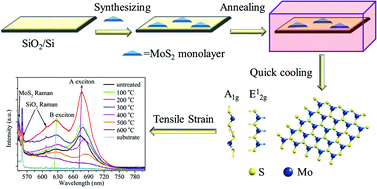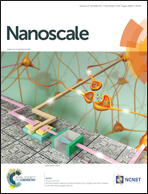Bandgap modulation of MoS2 monolayer by thermal annealing and quick cooling†
Abstract
We developed a non-mechanical straining method to simultaneously modulate the bandgap and photoluminescence (PL) quantum efficiency of a synthesized molybdenum disulfide (MoS2) monolayer on SiO2, by vacuum annealing and subsequent quick cooling in ethanol. Influences of the thermal treatments at different temperatures from 100 °C to 600 °C on the PL and Raman spectra of the MoS2 monolayers are reported. A maximum PL peak intensity, twice that of the untreated counterparts under the same measurement conditions, was observed at the treating temperature of 200 °C. At the same time, approximately permanent tensile strains were induced, due to the quick cooling from high temperatures, which led to a red-shift of the direct optical bandgap. Modulation of the bandgap was achieved by changing the treating temperatures; nearly linear PL and Raman frequency shifts of ∼3.82 meV per 100 °C and ∼−0.28 cm−1/100 °C for A exciton photoluminescence and Raman E12g mode frequency were observed, respectively. The proposed thermal modulation promises a wide range of applications in functional 2D nanodevices and semiconductors. To our knowledge, our findings constitute the first demonstration of thermal engineering by combinational manipulation of annealing and quick cooling of the 2D transition-metal dichalcogenides.


 Please wait while we load your content...
Please wait while we load your content...